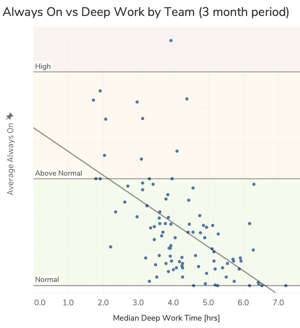
There are many factors that impact productivity—workload, fire drills, interruptions from coworkers (or roommates)—on any given day. We adapt to get things done on time, but one factor can make or break our success: Deep Work.
Diving Into Deep Work
We describe Deep Work as two or more hours of uninterrupted working time. (Yes, meetings count as interruptions.) The concept applies to all roles in an organization, but we naturally focus on the value for software developers.
In today’s “ping culture” of frequent Slack messages and impromptu huddles, uninterrupted focus time can seem like an elusive dream, rather than a typical workday. When it’s hard to find time for Deep Work, some wonder if it’s worth canceling meetings to accommodate.
We maintain that Deep Work is a cornerstone of engineering effectiveness. Recent findings shed some light on this issue.
Keeping Burnout at Bay
To understand the benefits of Deep Work, we’ll first visit the idea of “Always On.” This Uplevel metric takes stock of burnout risk behaviors, like working long hours and responding to Slack messages on weekends. (We created this tool in response to the pandemic-induced pivot to remote work, when work/home boundaries were blurred.)
Burnout is a high-impact obstacle. It takes longer to recover from burnout than it does to prevent it. If you run for miles and take a break, you can likely pick up and run a couple more—but if you ignore that call for breaktime and instead push yourself ten more, you’ll need a much longer recovery time before you next lace up your shoes.
This Uplevel metric takes stock of burnout risk behaviors, like working long hours and responding to Slack messages on weekends. This metric accounts for each person’s individual schedule that can vary every day. (We created this metric in response to the pandemic-induced pivot to remote work, when work/home boundaries were blurred, and individuals take breaks to home-school children etc.)
THE CONNECTION BETWEEN DEEP WORK AND BURNOUT RISK
Can interrupted Deep Work time help developers reach their goals while keeping burnout risk low? To answer this question, we analyzed existing customers and explored the relationship between Deep Work and Always on. The result was clear. There was a statistically significant correlation between Deep Work and Always On — teams with more Deep Work time tend to have lower Always On scores.

This relationship holds both at the team level, as well as at the individual contributor (IC) level. However, there is a stronger link when looking at teams.
WORKING ON TIME, NOT OVERTIME
More Deep Work is associated with a lower in Always On risk—showing that, when engineers have sufficient time to focus, they have less of a need to work beyond a full day. One way we have heard this manifest for developers is that they get caught up in meetings and short work blocks all day, and then need to catch up on the day’s Pull Requests and Slack messages in the evening or weekend to unblock their teammates.
Our 2020 State of Engineering Report stemmed from a survey of over 3,000 engineers that inquired about work behaviors and obstacles. A concerning 50% of the respondents reported “not enough time to do work” on a regular basis (2+ times per week), while 20% feel that on a daily basis.
One culprit? Meetings. The average worker attends 15 meetings per week. Add coffee breaks, lunchtime, last-minute Zoom check-ins, and requests for assistance, and the seemingly eight-hour workday becomes a series of short, 45-minute fragments of productivity. Research shows that after an interruption, it takes 23 minutes to return to the original task. It’s no surprise, then, that the #1 time-waster chosen was “too many meetings.”
How can engineering teams increase their Deep Work time? One clear path forward involves reducing the number or duration of meetings. Teams can also shift meetings to one half of the day, leaving the other typically open for focused working time. Lastly, cultural shifts that reduce Slack interruptions, limit meeting attendee lists, or encourage Do Not Disturb settings can help protect Deep Work focus.
Learn more about how Uplevel helps companies manage velocity in their engineering organizations while avoiding all-too-common burnout.

